Aguinaldo class Patrol Craft (2 + 0
+ 1)
PG 140 BRP Emilio Aguinaldo
PG 141 BRP Antonio Luna
Type: Large Patrol Craft/ Off Shore Vessel
Displacement, full load: (209 T standard); 215 T
Dimensions: 44 m x 6.2 m x 1.6 m (144.4' x 20.34'
x 5.2')
Main Machinery: 4 x 2,040 hp (1.52 mW) Detroit
12V 92TA diesels, 4 shafts; 2 x GM-EMD 6-71 auxilliary
diesels, 60 kW generator
Speed: [max] 25 knts; [cruising] 12 knts
Range: 2,035 km (1,265 mi)
Complement: 6 Officers + 52 Ratings
Weapon Systems
Main Gun: 2 x Bofors 40 mm/60
Range: [AA] 7.16 km (3.87 nm)
Rate of Fire: 120 rpm
Gunfire Control System:
Rangefinder: Optical
Secondary Gun: 2 x Oerlikon 20 mm
Range: [AA] 2 km (1.06 nm)
Gunfire Control System:
Rangefinder: Optical
Tertiary Gun: 4 x 12.7 mm HMG
Range: 1.80 km
Rate of Fire: 450 rpm
Gunfire Control System: Manual
Rangefinder: Optical
Radars
Surface Search:
Range:
Navigation:
Sonar:
Builders: Cavite Naval SY
Year(Commissioned in PN): PG 140 21 November
1990; PG 141 1998
Program: Philippine-built patrol crafts, PG 140
launched in 23 June 1984 but only completed in 1990, PG
141 completed in 1998. The program has been badly delayed
by budget constraints, where the hulls have already been
built but internal components and equipments, most which
are imported have been purchased in batches, contributing
to the ship's completion delay. The planned 3 additional
units will not be built. A third hull, PG 142 paid off
and is used as spare. These ships serves in the
Philippine Fleet's Patrol Force.
Structure: Steel-hull design based on
Tirad Pass, a large patrol craft built for the PCG by
Japan in 1974. Superstructure is based on the Kagitingan-class.
The largest of the locally built ships by the Cavite
Naval SY. Appears to be underpowered and overcrewed.
Modernization: PG 140 underwent an
overhaul in 1994. There were plans before to upgrade the
armament in time to include an OTO Melara 76 mm/62 gun
and SAM, but were shelved.


Photo of PG 141 BRP
Antonio Luna at top and PG 140 BRP Emilio Aguinaldo below.
Back to top
Kagitingan class Small Patrol Craft
(2+ 1)
PG 102 BRP Bagong Lakas
PG 104 BRP Bagong Silang
Type: Coastal Patrol Interdiction Craft
Displacement, full load: (136 T standard); 160 T
Dimensions: 37 m x 6.2 m x 1.7 m (121' 3" x
20' 3" x 5' 7")
Main Machinery: 2 x 2,050 hp Mercedes-Benz MTU16V538TB91
MD 871/30 16-cylinder diesels, 2 shafts; 2 x GM-EMD 6-71
auxilliary diesels , 60 kW generator
Speed: [max] 21 knts; [cruising] 12 knts
Range: 3,700 km (2,300 mi)
Complement: 4 Officers + 26 Ratings
Weapon Systems
Main Gun: 1 x Emerlec 30 mm EX-31 Electric mount
(Twin)
Range:
Rate of Fire:
Gunfire Control System: Selenia Elsag NA 10 Mod.0
GFCS
Rangefinder: Orion10x Fire Control Radar
Secondary Gun: 4 X 12.7 mm HMG
Range: 1.80 km
Rate of Fire: 450 rpm
Gunfire Control System: Manual
Rangefinder: Optical
Radars
Surface Search:
Range:
Navigation:
Sonar:
Builders: W. Muller, Hameln, Germany (PG 101);
Cavite Naval SY (PG 102, PG 104; Philippine Dockyards
Corporation (PG 103)
Year(Commissioned in PN): PG 101 1979; PG 102
1979; PG 104 June 1983
Program: Sometimes, called Bagong Lipunan class,
these are German designed boats; with the first two built
in Germany, others assembled at Cavite, perhaps from kits.
There is some confusion as to which are actually in
service. PG 103 Katapangan is used as a "spare".
PG 101 was reportedly decommissioned by 2004, with its
weapons removed and its hull rusting at Cavite SY. Its
fire control radar antenna was still intact. This ship
was probably the one salvaged during Balikatan exercise
in 2006. These ships serves in the Philippine Fleet's
Patrol Force.
Structure: An unsuccessful design,
underpowered being not able to achieve design speed of 28
knots. Hull is of semi-planing type marine grade mild
steel with a round mid body and a flat afterplane.
Supersructure is marine aluminum alloy. Main deck
watertight from stem to stern and to shell. Pilothouse
steering and propulsion controls arranged to permit one-man
controls. Communications systems installed adjacent to
the pilot house and make them readily accessible.
Discarded by 1992 but some units reactivated in 1994. In
2006, joint units of the USN's Mobile Diving Salvage Unit
1 and the PN's Underwater Construction Team, Naval
Construction Brigade, were able to salvage a sunken
Kagitingan-class patrol craft, during the Balikatan 2006
exercises, where they spent a week patching-up holes on a
fifteen-foot portion of the ship's hull, and pumping the
water out. It is not known if the ship is still in
operable condition.
Modernization: PGs 102 and 104 underwent
an overhaul in 1994, including modernization of their 30
mm guns.
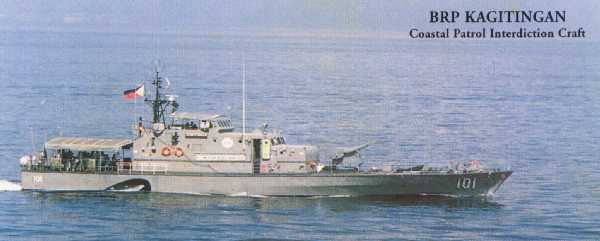
Photo of PG 101 BRP
Kagitingan during its heyday.
Back to top
Batillo (Sea Dolphin/PKM 200 'Chamsuri')
class Small Patrol Craft (6 + 1)
PG 111 BRP Boni Serrano (ex SK PKM 226)
PG 112 BRP Bienvenido Salting (ex SK PKM 229)
PG 114 BRP Salvador Abcede (ex SK PKM 231)
PG 116 BRP Nicolas Mahusay
PG 117 BRP Dionisio Ojeda (ex SK PKM 232)
PG 118 BRP Emilio Liwanag (ex SK PKM 223)
Type: Patrol Gunboat
Displacement, full load: (110 T standard); 142.8
T
Dimensions: 37 m x 6.92 m x 1.75 m (121.36' x 22.70'
x 5.74')
Main Machinery: [PG 110, 112, 115] 2 x 10,000
bhp Motorinen Turbin en Union MTU 16V538 TB90 diesels, 2
shafts; 2 x 50 kW diesel sets [PG 111, 114, 116, 118] 2 x
6,300 hp Caterpillar 3615c diesels, 2 shafts; 2 x diesel
sets
Speed: [max] 32 knts; [cruising] 23 knts
Range: 1,690 km (1,050 mi) at 20 knts
Complement: 5 Officers + 26 Ratings
Weapon Systems
Main Gun: 1 x Bofors 40 mm/60
Range: 11 km (5.9 nm); [AA] 7.16 km (3.87 nm)
Rate of Fire: 120 rpm
Gunfire Control System:
Rangefinder: Optical
Secondary Gun: 1 x Emerlec 30 mm Electric mount
(Twin) or 2 x 20 mm GE Sea Vulcan Gatling gun
Range:
Rate of Fire:
Gunfire Control System:
Rangefinder:
Tertiary Gun: 2 x Oerlikon 20 mm
Range: [AA] 2 km (1.06 nm)
Rate of Fire: 450 rpm
Gunfire Control System:
Rangefinder: Optical
Radars
Surface Search: Raytheon 1645
Range:
Navigation: Raytheon 1645
Sonar:
Builders: Korea Tacoma SY, Chinhae, South Korea;
Korea SB & Eng., Masan, South Korea.
Year(Commissioned in PN): PG 110-114 22 May 1996;
PG 116 2 July 1998; PG 117 2007; PG 118 May 2011
Program: Ex-South Korean boats (which has about
85 of this class in their inventory including missile
boat variants with two Exocet SSMs), built in 1970-1980's,
transferred in 15 June 1995 and commissioned in 1996. PG
116 delivered in 1998 PN negotiated for additional 2
units from Korea in 2004. On 30 May 2006, the Philippines
Navy received two more second-hand PKM 200 Sea Dolphin (Wild
Cat) class patrol boats from South Korea. An invitation
to bid for the transportation of these vessels from
Chinhae Naval Base, Jinhae, Busan, South Korea to Manila
South Harbor Anchorage Area, Manila, Philippines was
issued on 24 June 2005 under an approved budget of Php 9.25
million, chargeable against the AFP Modernization Program
FY 2002 Funds. Among the fastest ships in the PN
inventory, these ships serves in the Philippine Fleet
Patrol Force.
Structure: PG 112 is armed with one bow
twin 30 mm one, aft Mk.3 Bofors 40 mm, two bridge wings
20 mm, four forecastle 12.7 mm and two 12.7 mm aft, with
manual optical fire control system atop the bridge. This
is the common weapon configuration of this class. PG 114
has a 40 mm main gun instead of the twin 30 mm, with the
same secondary armaments as the others. PG 116 has a 20
mm Vulcan main gun forward, two bridge wings 20 mm, two
forecastle 12.7 mm and one Bofors 40 mm aft.
Modernization: Transferred from Korea in
1995 and went into refit at Sangley Point SY. PG 116 was
initially to be kept as a spare. Proposals for the
replacement of the MTU diesels with GM diesels, may have
been shelved. Upgrade of PG 111 and PG 116 (which was
initially to be used as a spare) with an approved budget
of Php 288 million, was made by Propmech Corp., involved
stripping and replacement of all major systems of the
vessels (including communication, navigation equipments,
new Koden radars, new Caterpillar diesel engines) which
were completed by 2008. PG 114 upgraded in 2009, PG 118
upgraded in 2010. All upgraded ships are fitted with
Level 4 Armor protection (proof against 7.62 mm) covering
the wheel house.

PG 116 BRP Nicolas
Mahusay photo from PN taken in 2002.
Back to top
Yap (Seahawk/Sea Killer/Schoolboy)
class Patrol Craft Fast (4)
PG 840 BRP Conrado Yap*
PG 842 BRP Tedorico Dominado Jr.*
PG 843 BRP Cosme Acosta*
PG 844 BRP Jose Artiaga Jr.*
PG 846 BRP Nicanor Jimenez*
PG 847 BRP Leopoldo Regis
PG 848 BRP Leon Tadina*
PG 849 BRP Loreto Danipog
PG 851 BRP Apollo Tiano
PG 853 BRP Sulpicio Fernandez
Type: Fast Attack Craft (G)
Displacement, full load: (65.35 T standard); 74.48
T
Dimensions: 25.47 m x 5.4m x 1.2 m (83.64' x 17.72'
x 3.94')
Main Machinery: 2 x 2,600 bhp MTU 16V538 TD 90
diesels, 2 shafts; 1 x Mitsubishi GDS 70MP auxilliary
diesels, 60 kW generator
Speed: [max] 38 knts; [cruising] 25 knts
Range: 804 km (500 mi) at 20 knts
Complement: 3 Officers + 12 Ratings
Weapon Systems
Main Gun: 1 x Bofors 40 mm/60
Weight of shell: 0.9 kg (1.98 lb)
Range: 11 km (5.9 nm); [AA] 7.16 km (3.87 nm)
Rate of Fire: 120 rpm
Gunfire Control System:
Rangefinder: Optical
Secondary Gun: 2 X Oerlikon Mk. 16 20 mm (Twin)
Range: [AA] 2 km (1.06 nm)
Rate of Fire: 450 rpm
Gunfire Control System:
Rangefinder: Optical
Radars
Surface Search:
Range:
Navigation: Raytheon 1645
Sonar:
Builders: Korea SB & Eng., Masan, and Korea
Tacoma SY, Chinhae
Year(Commissioned in PN): 1975-1978/1995-1998
Program: South Korean ships built during 1975
and 1978. Korea sold twelve units to PN in 1993 in a
Memorandum of Understanding, at a friendly price of $100
each, as a gesture of appreciation to the PEFTOK soldiers
who fought during the Korean War. The first six units
were commissioned in 1995 and another six in 1998. The
deal also included seven hundred twenty-nine units of
spare parts for use of the PKMs shipped to the country in
1998, 150,000 rounds of 20 mm ammunition shipped in 1995
and twelve units of propellers for the PKM acquired in
1997. Additional two units were negotiated in 2003 were
expected before end of 2006. PGs 844, 847, 851 and 853
serves in the Philippine Fleet's Patrol Force. Utilized
as high speed interceptors of three units per task force
to combat high-speed raiders and pirates rampant in
Southern Philippines.
Structure: Some units were reportedly
seen with external bolt-on fuel tanks aft to provide
additional range. Weapon Systems vary. The 20 mm guns
maybe replaced by four 12.7 mm machine-guns including two
in twin-turreted configuration located aft. Most of the
ships are also equipped with satellite radio dish for
communications. Sister ships 845 and 852 have been
numbered but not been reactivated and are probably used
as spares.
*Note: PG 840, PG 842, PG 843, PG 846,
and PG 848 were reportedly decommissioned in 7 June 2001.
PG 844 was reportedly decommissioned in 13 Dec 2010.

File photo of a SK
Navy Seakiller. patrol craft..
Back to top
Point
class Cutter (2)
PG 394 BRP Alberto Navarette (ex USCGC Point
Evans WPB 82354)
PG 396 BRP Abraham Campo (ex USCGC Point Doran WPB 82375)
Type: Small Patrol Craft
Displacement, full load: 69 T
Dimensions: 25.25 m x 5.36 m x 1.8 m (82.83' x
17.58' x 5.92')
Main Machinery: 2 x 600 hp Caterpillar D3412
diesels, 2 shafts
Speed: 22.9 knts
Range: 542 nm at 18 knts; [cruising] 1,500 nm at
9.4 knts
Complement: 10
Weapon Systems
Main Gun: 4 x 12.7 mm HMG
Range:
Rate of Fire:
Gunfire Control System: Manual
Rangefinder: Optical
Radars
Surface Search: SPS-64
Range:
Navigation: Hughes-Furuno SPS-73
Sonar:
Builders: J.M. Martinac SB Corp., Tacoma,
Washington (PG 394); USCG Yard, Curtis Bay, MD (PG 396)
Year(First commissioned/Commissioned in PN): PG
394 10 January 1967/ 2000; PG 396 1 June 1970/ 2000
Program: First built in the 60' for the USCG.
The Point class cutters were used by the USCG for law
enforcement and SAR operations. Huynh Van Duc HQ 702 (ex
USCGC Point Clear WPB 82315) escaped from South Vietnam,
April 1975, scrapped in Subic Bay on 1976. PG 394 (ex WPB
82354) was formerly based at Long Beach, California and
in Hawaii. PG 396 (ex WPB 82375) was assigned to Group
Seattle and was formerly based at Everett, Washington.
Transferred by donation to the PN.
Structure: Built to Coast Guard standards with
mild steel hulls and aluminum superstructures.
Longitudinally framed construction was used to save
weight. Originally carried a 20 mm, five 12.7 mm and an
81 mm mortar. Original electronics included SPN-11 and CR-103
(1960s). Original engine was two 800 hp Cummins diesels,
being replaced by the Caterpillar diesels in 1990. Fuel
capacity is 1,840 gallons.

Photo of PG 394 BRP
Alberto Navarette, Point-class cutter.
Back to top
Andrada (Halter 78) class Coastal
Patrol Craft (22)
PG 370 BRP Jose Andrada
PG 371 BRP Enrique Jurado
PG 372 BRP Alfredo Peckson
PG 374 BRP Simeon Castro
PG 375 BRP Carlos Albert
PG 376 BRP Heracleo Alano
PG 377 BRP Liberato Picar
PG 378 BRP Hilario Ruiz
PG 379 BRP Rafael Pargas
PG 380 BRP Nestor Reynoso
PG 381 BRP Diocoro Papa
PG 383 BRP Ismael Lomibao
PG 384 BRP Leovigildo Gantioque
PG 385 BRP Federico Martir
PG 386 BRP Filipino Flojo
PG 387 BRP Anastacio Cacayorin
PG 388 BRP Manuel Gomez
PG 389 BRP Teotimo Figuracion
PG 390 BRP Jose Loor Sr.
PG 392 BRP Juan Magulayan
PG 393 BRP Florencio Iñigo
PG 395 BRP Felix Apolinario
Type: Small Patrol Craft/Gunboat
Displacement, full load: (49.5 T standard); 56.4
T
Dimensions: 23.8 m x 6.1 m x 1.8 m (78' x 20' x
5.75')
Main Machinery: 2 x 2,800 hp GM 16V92 TAB diesel,
2 shafts; 2 x 35 kW auxilliary diesel sets
Speed: [max] 28 knts; [cruising] 24 knts
Range: 1,930 km (1,200 mi) at 12 knts
Complement: 1 Officer + 7 Ratings
Weapon Systems
Main Gun: 1 x M-242 25 mm Bushmaster low angle,
chain gun
Range: 2.46 km
Rate of Fire: 175 rpm
Gunfire Control System: Manual or Electric
Rangefinder: Optical
Secondary Gun: 4 X 12.7 mm HMG
Range: 1.80 km
Rate of Fire: 450 rpm
Gunfire Control System: Manual
Rangefinder: Optical
Radars
Surface Search: Raytheon SPS-64(V)11
Range:
Navigation: Raytheon SPS-64(V)11
Sonar:
Builders: Halter-Marine, Trinity-Equitable SY,
New Orleans, USA & Atlantic Gulf & Pacific Co.,
Batangas, Philippines.
Year(Commissioned in PN): PG 370 August 1990; PG
371-374 June 1991; PG 375-377 January 1992; PG 378-381
June 1995; PG 383 1995; PG 384-386 May 1996; PG 387 1996;
PG 392-393 July 1998; PG 395 November 2000
Program: Brand-news units, first four acquired
in early 1989 for $ 9.4 million and built in New Orleans
under FMS. Four more units were procured in 1990. The
last sixteen units were built in co-production with
Halter Marine and A.G.&P. Co. (Marine), Inc SY in
Batangas from 1990 to 2001, through FMS. DF 379 and 380
were launched in 1995 by AG & P. Each ship cost about
$2.25 million each. About thirty-five originally planned
to be bought, the last eleven ships were scrapped in
favor of South Korean ships. The aim of these ships is
for twenty-five crafts to be divided into five squadrons
each based on a support ship and spread throughout the
archipelago. These ships serves in the Philippine Fleet's
Assault Craft Force.
Structure: Built to Coast Guard
standards with aluminum hull and superstructure. PGs 370
to 378 are 77 feet, the rest beginning with 379 are 78
feet. Originally carried one bow 40 mm gun, one 81 mm
mortar aft and four 12.7 mm HMGs. Earlier models (370-377)
does not sport the unstabilized M-242 25 mm Mk. 38 "Bushmaster"
naval chain gun and the pilothouse gunshields. .Carries a
4 m rigid inflatable boat powered by a 40 bhp outboard
motor, which is stowed amidships. This ship was the trial
platform for Aerospatiale's AS15TT light anti-ship
missile in 1995. PG 376 was the trial plaform for the PN
Trident Strike RCWs.
Modernization: Plans to refit the ships
with stabilized Mk. 38 25 mm mounts shelved since average
engagement ranges encountered by ships of this class,
often under 500 m. Most of the older units due for
overhaul. Juan Magluyan spent time in dry dock at
Colorado SY in Cebu in 2005, while Filipino Flojo spent
time in dry dock there during 2006. Six to eleven units
were reportedly to be armed with AS15TT SSMs or Hellfire
missiles in the future.
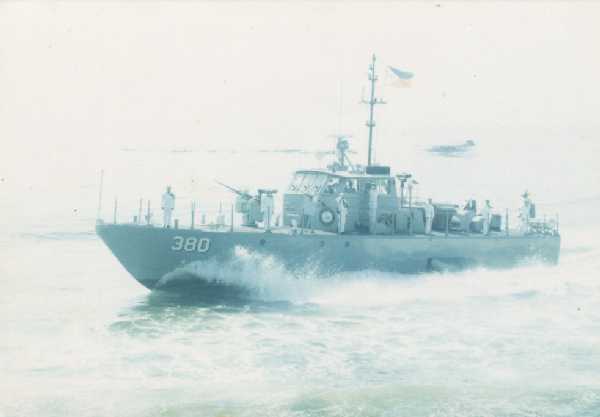  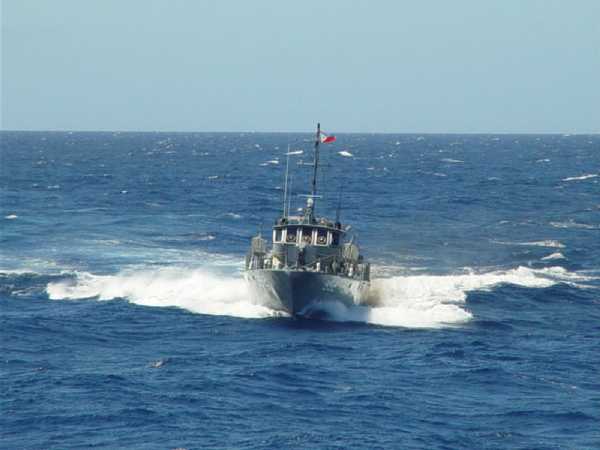
PG 380
BRP Nestor Reynoso and PG 392 BRP Juan Magluyan.
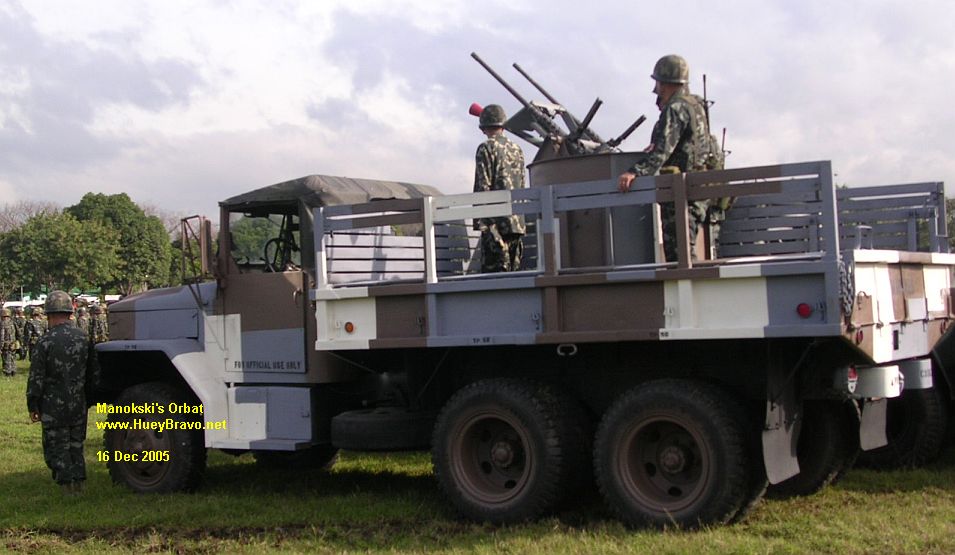  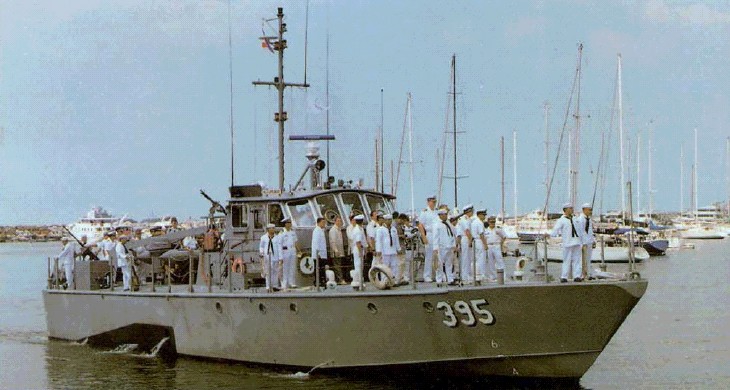
Photos of PG 376 BRP
Heracleo Alano and PG 395 BRP Felix Apolinario Andrada-class
gunboats.
Back to top
Swift
Mk. 3 class Small Patrol Craft (4)
DF 351
DF 352
DF 353
DF 354
Type: Inshore Patrol Craft
Displacement, full load: (29 T standard); 37 T
Dimensions: 19.8 m x 4.9 m x 1 m (65' x 16' x 3.4')
Main Machinery: 2 x 840 hp (616 kW) GM 12V-71-T1
diesels, 3 shafts
Speed: 25 knts
Range: 685 nm at 16 knt
Complement: 8
Weapon Systems
Main Gun: 2 x 12.7 mm HMG bow
Range: 1.80 km
Rate of Fire: 450 rpm
Gunfire Control System: Manual
Rangefinder: Optical
Secondary Gun: 2 x 7.62 mm LMG aft
Range: 1.1 km
Rate of Fire: 100 rpm
Gunfire Control System: Manual
Rangefinder: Optical
Radars
Surface Search: Koden I band
Range:
Navigation:
Sonar:
Builders: Seward Seacraft, Burwick, Louisiana
Year(Commissioned in PN): 1972-1976
Program: Built on 1969-1970. Improved version of
Swift-type inshore patrol boats built by Sewart for the
PN. Delivered 1972-1976. Most of the units have been
transferred to the Philippine Coast Guard, others
discarded while a few remain in active duty.
Structure: Aluminum hulls, redesigned
version. Mk. 3 was used by the USN as a trial platform
for the Penguin anti-ship missile.
Modernization: Several units refitted/refurbished
in 1997.

Swift Mk. 3 PG 341
Inshore Patrol Vessel
Back to top
Swift
Mk. 1/Mk. 2 class Small Patrol Craft (4/8)
DF 300 (ex USN PCF 6633)
DF 301 (ex USN PCF 6634)
DF 302 (ex USN PCF 35)
DF 303 (ex USN PCF 36)
DF 305 (ex USN PCF 38)
DF 307 (ex USN PCF 682)
DF 308 (ex USN PCF 683)
DF 309 (ex USN PCF 684)
DF 310 (ex USN PCF 685)
DF 311 (ex USN PCF 686)
DF 312 (ex USN PCF 687)
DF 313 (ex USN PCF 688)
Type: Inshore Patrol Craft
Displacement, full load: 22.5 T
Dimensions: 15.28 m x 4.13 m x 1.2 m (50.13' x
13.54' x 4') [Mk.1]; 15.6 m x 4.13 m x 1.2 m (51.3' x 13.54'
x 4') [Mk.2]
Main Machinery: 2 x 680 hp (504 kW) GM 12V-71-N
diesels, 2 shafts
Speed: 28 knts
Range: [max] 350 nm at 28 knts; [cruising] 1,100
km (684 mi) at 16 knts
Complement: 1 Officer + 5 Ratings
Weapon Systems
Main Gun: 2 x 12.7 HB HMG (Twin, Mk. 51 tub
mount)
Range: 1.80 km
Rate of Fire: 500-600 rpm
Gunfire Control System: Manual
Rangefinder: Optical
Secondary Gun: 2 x M-79 40 mm grenade launchers
Range: 685 nm at 16 knts
Rate of Fire:
Gunfire Control System:
Rangefinder:
Radars
Surface Search: Decca D202 I band
Range: 14.92 km (24 mi)
Navigation:
Sonar:
Builders: Seward Seacraft, Burwick, Louisiana
Year(Commissioned in PN): 1966-1970
Program: Adopted from an oil rig crew boat used
to support offshore drilling rigs. All specifications for
the Mk.1 and Mk.2 are similar. Built on 1965-1966 (20
units Mk.1) and 1968 (Thirty units Mk.2) in which three
Mk.2s served in Vietnam. DF 300-303 are Mk.1 DF 305, DF
307-313 are Mk.2. Most of the units have been transferred
to the Philippine Coast Guard, others discarded while a
few remain in active duty. Mission endurance is 5 days.
Structure: Hull and superstructure
constructed from all-welded, ¼" 5086-H321 aluminum
alloy, including all deck plating, bulkheads and
structural members. All extrusions are constructed from
5086-H311 aluminum alloy. On Mk.2 boats, bow height was
raised by one foot and the pilothouse was moved aft by
approximately three feet, from the Mk.1 construction
plans design. Two to four magnesium anodes located below
the waterline at the stern, provided for reducing
underwater electrolytic corrosion. Main propulsion is
generated by two 12-cylinder, General Motors 12V71-N
Detroit marine diesels, port model #7122-3000, starboard
model #7122-7000 equipped with two 4-71 blowers, and
rated at 480 hp, when using the N70 type injectors,
driving a 28" bronze propellers. SM-118 hydraulic
marine gear clutch reduction gearbox, with a reduction
ratio: 1.15:1. Fuel capacity is 828 gallons, diesel or JP-5
in an emergency, in three fuel tanks (2 aft, 1 amidships).
Electricity supplied by two 24V batteries, each charged
by its alternator, providing power for the main engine,
starting, general purpose lighting, search lights,
navigational lights, radar and the URC-58 radio (alternate
mode). Port bank, standby 24V supply, while starboard
bank, is used for general boat power. In an emergency,
these banks could be put in a parallel mode configuration,
to ensure operation of vital equipment. Fresh water
capacity is 60 gallons. Electronics includes Decca D202 (3
cm) surface search radar - with a maximum range scale of
15 kilometers (24 miles), with fixed range rings and a
relative bearing presentation. Range discrimination is 30
yards, on the 1.5 mile scale, with a bearing accuracy of
1°. Maximum detection range of a small wooden boat was 3
miles, with an estimated 90% detection of small boats at
1 mile. In average sea conditions, a 90% detection rate,
for steel hulled trawlers, could be assumed at 5 miles.
Power consumption was 200 W DC only; a Raytheon DE176A
Fathometer - dual range (240 foot maximum depth); an AN/URC-58
Single Side Band radio, 2-15 MHz, could operate on upper
sideband, lower sideband, AM or CW, output is 100 W, and
is the PCF's primary communications equipment. This radio
normally operated on 120 V DC power but could be operated
on 24V DC if necessary; an AN/VRC-46 FM radio, 30.00-79.95
MHz (short range - boat to boat or boat to shore for
coordination with other units); an AN/PRC-10/25 FM, 30.00-79.95
MHz portable field radio (used by off boat inspection
parties and to coordinate with other units ashore); an AN/PRC-41
UHF portable radio (surface to air communications); and
an AN/URC-4 Survival/Emergency radio. Endurance depends
on fuel consumption and sea condition from 10.7 hours at
23.5 knots to 100 hours at 8.1 knots. Can survive Sea
State 2 with 4.5 knots overall speed. Gun tub, Mk. 51
mounted at the rear of the pilothouse. A total of one
hundred seventy-one Mk.1, Mk.2 and Mk.3 Swift boats were
constructed for the USN, the PN, Thailand, Cambodia,
Brazil and Zaire. In addition, the Philippines and South
Vietnam each built one prototype ferro-cement Swift boat,
with enlarged superstructure as part of a US sponsored
program for inexpensive mass production of the craft.

A Swift Mk. 2 PG 313
Inshore Patrol Vessel with PCG stripes.
Back to top
MPAC Mk.1 & Mk.2 (6 + 0 + 3)
BA-482
BA-483
BA-484
BA-485
BA-486
BA-487
Type: Multi-purpose Attack Craft
Displacement, full load: 6.5 T
Dimensions: 15 m x 4.76 m x 2.1 m (50' x
15.6' x 6.8')
Main Machinery: 1 x diesel motor and ??
x waterjet
Speed: 40 knts
Range: 300 nm at 30 knts
Complement: 1 Officer + 3 Ratings + 20 Commandos
Military Lift: T
Weapon Systems
Main Gun: 1 X 12.7 mm HMG
Range: 1.80 km
Rate of Fire: 450 rpm
Gunfire Control System: Manual
Rangefinder: Optical
Secondary Gun: 2 x 7.62 mm LMG
Range: 1.1 km
Rate of Fire: 100 rpm
Gunfire Control System: Manual
Rangefinder: Optical
Radars
Surface Search: Furuno UHD Digital Radar
Range:
Navigation:
Sonar:
Builders: Lung Teh Shipbuilding Co. Ltd., Taiwan;
Propmech Philippines
Year(Commissioned in PN): Mk.1 2009/ May 2009;
Mk.2 2012
Program: Brand new units, locally designed CB-90
knock-off, built to PN specs and is used for fast
interdiction or rapid troop insertion for special
operations even in shallow waters and operates from a
mothership. Could carry sixteen fully equipped soldiers
and four crew members or around two tons payload. Armed
with one 12.7 mm heavy machine gun with a maximum load of
2,000 rounds and two M60 or 7.62 mm light machine guns
with 4,000 rounds. One unit procured and operated by DOE
and used by forces guarding the Malampaya oil rig, while
the other two operated by the PN. Three MPAC Mk.2,
incorporating improvements on the Mk.1 have been
delivered in 2012 by local shipbuilder, Propmech. Three
more MPACs are scheduled to be acquired for Php 90-M each
within 2013 to 2017. These MPACs are part of the Navy's
Medium-term CUP.
Structure: Made of welded aluminum and Kevlar
materials, with a low profile stealth-like design.
Heavily reinforced bow ramp for forceful landing on any
unprepared beaches. Fitted with Level 4 Armor Protection
(proof against 7.62 mm) covering the wheel house, the
transport room and the engine room. Equipped with the
latest navigation system and water jet system that could
reach a maximum speed of 40 knots and could reach around
300 nautical miles while traveling on a transit speed of
30 knots. Capable of operating in littoral waters up to
Sea State 3.
Back to top
1513348A Silver Ships class Riverine
Patrol Craft (6)
Type: Riverine Patrol Craft
Displacement, full load: ( T standard) T
Dimensions: 12.2 m x 3.25 m x 0.61 m (40' x 10'8"
x 2')
Main Machinery: 2 x 220 hp ( 1.64 mW) Yanmar 6LY2A-STP
diesels, 2 shafts; 2 x Hamilton HJ-292 waterjets
Speed: 40 knts
Range: [cruising] mi (at 15 knts)
Complement: ( Officers + Ratings)
Weapon Systems
Main Gun: 1 x 12.7 mm HMG
Range:
Rate of Fire:
Gunfire Control System: Manual
Rangefinder:
Secondary Gun:
Range:
Rate of Fire:
Gunfire Control System:
Rangefinder:
Other Defenses:
Radars
Surface Search:
Range:
Navigation:
Sonar:
Builders: Silver Ships Inc., Theodore, Ala
Year(Laid Down/First Commissioned/Commissioned in PN): 2012/
August 2013/ August 2013
Program: Built for the Navy’s FMS program,
the 40'×10'8" RPBs feature a center console
configuration with the bow area capable of transporting
troops and equipment in support of maritime green-water
patrols and providing rapid egress through a bow door.
Structure: Designed and constructed with marine-grade
aluminum, the RPB has been engineered to be beachable and
fully capable of shallow- and open-water operations.
It’s designed to facilitate maintenance, inspections
and repairs as needed to provide ease of operation and
extended service life. Main propulsion comes from twin
Yanmar 6LY2A-STP diesels, producing 440 hp at 3,300 rpm
each. The Laborde Products Inc.-supplied engines are
connected to Hamilton HJ-292 waterjets through ZF 280
marine gears. The propulsion package gives the RPB a
running speed of 40 knots. Ballistic protection was
incorporated into the design and the RPB has
“multiple crew-served weapon foundations.” The
contract includes trailers, onboard and deployable spares,
OEM technical manuals, boat manual and training.
Back to top
Last
modified on 9/18/13

|











